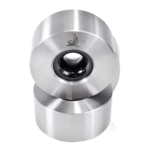Anhui Juxin Intelligent Manufacturing, Technology Co., Ltd. has earned a respected reputation in the diamond die industry over the last 30 years, providing high-quality products for industries worldwide. Among their product offerings, SCD drawing dies and SCD wire dies stand out due to their exceptional durability and performance in demanding wire drawing processes. In this article, we will explore the key differences between SCD drawing dies and PCD drawing dies, focusing on material composition, wear resistance, and their specific applications in precision wire manufacturing.
Material Composition and Structure
The primary distinction between SCD drawing dies and PCD dies lies in their material composition. SCD drawing dies are crafted from 111-oriented diamonds, which provide superior structural integrity and resistance to wear during extended use. PCD, on the other hand, is a composite material made from sintered diamond particles, which offers strength but can wear out faster under certain conditions. The choice between SCD wire dies and PCD dies often depends on the specific material being processed and the required precision. For high-value metals, SCD drawing dies offer an edge due to their predictable wear patterns and long-lasting performance.
Wear Resistance and Performance
One of the key advantages of SCD wire dies is their predictable wear patterns and recut size, ensuring consistent performance over time. This feature makes them an excellent choice for high-precision applications. Unlike PCD dies, which may exhibit irregular wear under heavy usage, SCD drawing dies offer a more predictable lifespan, making them ideal for industries requiring consistent wire quality. Moreover, SCD wire dies are designed to handle higher temperatures, adding to their resilience in extreme conditions. This is particularly beneficial when dealing with metals that have high melting points or when high-efficiency performance is a necessity.
Applications in Precision Wire Manufacturing
SCD drawing dies and SCD wire dies are widely used across various industries, particularly in the production of bonding wire (gold, copper and aluminum), medical wire (stainless steel or nitinol fine wires), and ultra-fine coaxial wires for communication and electronics. The ability of SCD drawing dies to handle a range of specialty alloys, such as nickel alloys and tungsten, makes them highly versatile in precision manufacturing. Juxin’s SCD wire dies are optimized for these applications, offering high wear resistance and recutting capabilities that extend the life of the dies and enhance the quality of the final product.
Conclusion
In conclusion, while both SCD drawing dies and PCD dies offer excellent durability and performance, SCD wire dies from Juxin stand out for their predictable wear patterns, high temperature resistance, and ability to work efficiently with high-value metals and specialty alloys. The choice between SCD drawing dies and PCD depends on specific application needs, but for industries that require precision, longevity, and high performance, SCD wire dies are an ideal solution. By selecting SCD drawing dies from Juxin, manufacturers can ensure the highest standards in wire production.


